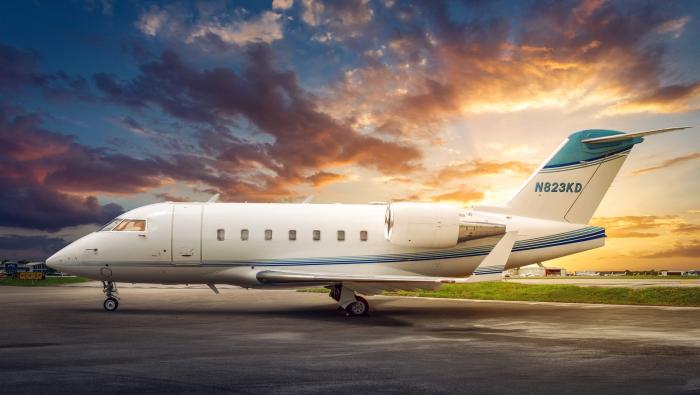Honeywell Aerospace has increased its 10-year business jet delivery forecast slightly to 7,700 new business jet deliveries from 2019 to 2028, up approximately two percentage points from last year’s prognostication, worth $251 billion. The forecast excludes very light jets and private versions of commercial aircraft, but the addition of bizliners would boost the totals to 7,900 aircraft worth more than $270 billion.
This year’s forecast, the Arizona-based OEM and aviation services provider’s 32nd edition, changed from previous years in that it does not include the totals from the current year, better aligning with forecast planning models used by the airframers. “If you want to compare to last year’s forecast for the same period of 2019 to 2028, this is about one percent higher in dollars or 50 aircraft more than last year,” noted Gaetan Handfield, the company’s senior manager of market research.
For this year, Honeywell (Booth 2600) sees business jet deliveries reaching between 630 and 640, which would be the lowest amount delivered since 2004. Handfield noted that total was affected by some program delays that resulted in aircraft entering service later than anticipated. “Because of that, some deliveries will not happen this year,” he said.
But the company sees signs of encouragement for next year. “A better used-aircraft market environment, coupled with the entry-into-service of many new business jet platforms, will lead to higher deliveries in 2019 after a virtually flat year in 2018,” explained Bill Kircos, Honeywell Aerospace’s vice president for global marketing. “We are excited about the used market and about new and innovative aircraft models that will not only drive solid growth in 2019 and 2020, but also have a significant impact on new business jet purchases in the midterm and long term.”
According to Handfield, the available used, young business jet inventory in the U.S. is down to 4 percent, a decrease he credits at least in part to the recent tax cuts and bonus depreciation. Overall, available young aircraft inventory has declined by 30 percent year-over-year and is currently almost three percentage points lower than the historical average of eight percent. “Once the inventory runs out of good airplanes, they are going to go international, which is what they're doing currently to brokers, and once that's gone, people are going to start buying new planes,” he said. For 2019, the forecasters predict high single-digit growth in deliveries.
Based on the results of Honeywell’s 2018 global outlook, which polled more than 1,400 corporate flight departments representing over 4,400 business aircraft, business jet operators expect to make new jet purchases equivalent to approximately 20 percent of their fleets over the next five years, up slightly from last year but still down several points from 2016’s survey.
While 14 percent of those purchases worldwide were expected to occur by the end of 2019, another 40 percent were slated between 2020 and 2021, indicating strong short-term activity. Super-midsize and large-cabin jets received 62 percent of all mentions and are expected to account for more than 87 percent of expenditures over the next half-decade.
The company’s longer-range forecast for the remainder of the decade predicts an annual growth rate of between three and four percent as new models, improved economic performance, and anticipated favorable exchange rates for international customers contribute to industry growth.
Among the most surprising results to Handfield in this year’s survey, was an increase in purchase intentions stemming from Europe. Those purchase intentions rose to 33 percent, 14 percentage points higher than last year and the best survey results from the region in the past five years. The results still indicate a cautious approach, however, with only 26 percent of the purchases planned for the first two years of the survey window.
“I think its post-Brexit anxiety," Handfield told AIN. “Brexit is not fixed at this point, but when you think about where we were last year, at least they are talking and negotiating, so I think that helped a lot.” Purchase intentions are the highest are England and Germany, he noted.
North America, which is home to 65 percent of the industry’s installed base, will be account for an estimated 61 percent of the global demand over the next five years, according to the survey respondents. Approximately 36 percent of operators there plan to schedule their new purchases within the first two years of the five-year survey window, 3 percent lower than last year, but still higher than the worldwide average of 30 percent.
Despite an increase from Brazil, Latin America's expected purchase plans dipped by 7 percent from a year ago. The survey, which was conducted earlier this summer, saw a decrease in near-term purchase intentions from Mexico, which may have been tempered by uncertainty that had surrounded the U.S. participation in the NAFTA agreement. Based on the current purchase plan levels, Latin America would represent 12 percent of total business jet demand over the next five years.
In this year's survey, the Middle East and Africa is projected to account for four percent of the global demand over the span of the survey. The percentage of respondents that indicated they will replace or add to their fleet declined from 18 percent to 14 percent year-over-year, impacted by political tensions and continued conflict in the area.
Operators in the Asia-Pacific region indicate a 12 percent acquisition plan for their fleet through 2023, which would account for 7 percent of global new jet demand over that period. Only 15 percent of Asian respondents plan their purchases within the next two years.







